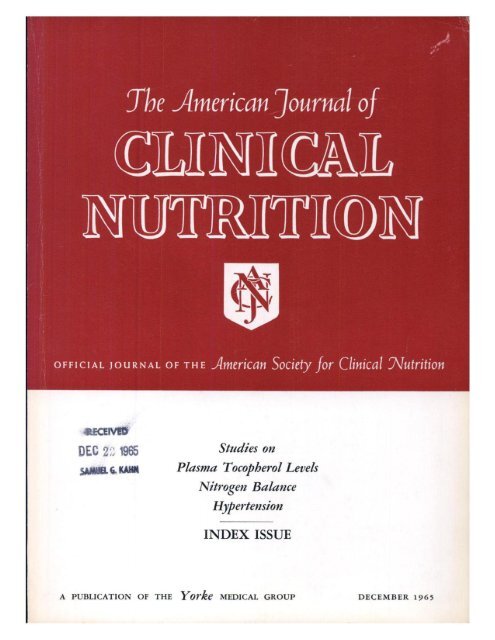联邦首都区尼日利亚成年人反式脂肪酸摄入量的血液生物标志物:一项横断面研究。
IF 6.5
1区 医学
Q1 NUTRITION & DIETETICS
引用次数: 0
摘要
背景:反式脂肪酸(TFA)的摄入量是心血管疾病的既定风险因素。2023 年 4 月,尼日利亚通过了限制食品、油脂中反式脂肪酸含量的法规,但目前尼日利亚人口的反式脂肪酸暴露水平尚不清楚。我们在政策实施前评估了联邦首都区尼日利亚成年人干血斑中的反式脂肪酸生物标志物,为今后的评估建立基线:方法:我们使用气相色谱法测量了参与横断面家庭调查的成年人干血斑中的反式脂肪酸含量。单个反式脂肪酸(t-16:1、t-18:1 和 t-18:2)及其总量以占总脂肪酸的百分比表示。我们使用多变量调整线性回归模型评估了基于性别、年龄、体重指数 (BMI)、教育程度、收入和地方政府辖区的亚组之间反式脂肪酸水平的差异。将平均反式脂肪酸水平与 30 个国家的样本进行了比较:在 213 名成年人(62% 为女性;平均年龄:36 岁;平均体重指数:25.9 kg/m2)中,干血斑中反式脂肪酸的平均含量为总脂肪酸的 0.61%(范围:0.23-1.31%)。在多变量调整模型中,年轻成人的反式脂肪酸含量更高(结论:这些结果为评估反式脂肪酸含量提供了基线:这些结果提供了尼日利亚成年人反式脂肪酸暴露的基线评估,以评估 2023 年通过的国家法规的实施情况和效果。观察到的亚组差异可能有助于确定需要采取针对性干预措施以减少反式脂肪酸摄入量的亚组人群。本文章由计算机程序翻译,如有差异,请以英文原文为准。
Blood biomarkers of trans-fatty acid intake among Nigerian adults in the Federal Capital Territory: a cross-sectional study
Background
Intake of trans-fatty acids (TFAs) is an established risk factor for cardiovascular disease. In April 2023, Nigeria passed regulations limiting TFA content in foods, fats, and oils, but the current level of TFA exposure in the Nigerian population is unknown.
Objectives
To quantify trans-fatty acid (TFA) biomarkers in dried blood spots from Nigerian adults in the Federal Capital Territory before policy enforcement, establish baseline levels for future evaluations, assess subgroup variations by demographic and socioeconomic factors, and compare TFA levels with data from 30 countries worldwide.
Methods
We used gas chromatography to measure TFA content in dried blood spots from adults participating in a cross-sectional household survey using a representative sampling frame. Individual TFA (t-16:1, t-18:1, and t- 18:2) and their total were expressed as percentage of total fatty acids. We assessed differences in TFA levels between subgroups based on sex, age, body mass index (BMI), education, income, and local government area using multivariable-adjusted linear regression models. Mean TFA levels were compared with samples from individuals in 30 countries.
Results
In 213 adults (62% females; mean age: 36 y, mean BMI: 25.9 kg/m2), the mean TFA level in dried blood spots was 0.61% of total fatty acids (range: 0.23%–1.31%). In multivariable-adjusted models, TFA levels were higher in younger adults {<30 y compared with ≥42 y, 0.07% [95% confidence interval (CI): 0.00, 0.15], P = 0.047}, those without a high school degree [compared with higher education, 0.08% (95% CI: 0.01, 0.16), P = 0.023], and residents of Abuja Municipal Area Council [compared with residents in Gwagwalada, 0.12% (95% CI: 0.05, 0.20), P = 0.001]. Total TFA levels were comparable with international samples, but t-16:1 and t-18:1 appeared lower, whereas t-18:2 appeared greater (52% of all TFA), in the Nigerian samples.
Conclusions
These results provide a baseline assessment of TFA exposure in Nigerian adults to evaluate implementation and effect of national regulation passed in 2023. The observed subgroup differences may help identify subpopulations for targeted interventions to reduce TFA intake.
求助全文
通过发布文献求助,成功后即可免费获取论文全文。
去求助
来源期刊
CiteScore
12.40
自引率
4.20%
发文量
332
审稿时长
38 days
期刊介绍:
American Journal of Clinical Nutrition is recognized as the most highly rated peer-reviewed, primary research journal in nutrition and dietetics.It focuses on publishing the latest research on various topics in nutrition, including but not limited to obesity, vitamins and minerals, nutrition and disease, and energy metabolism.
Purpose:
The purpose of AJCN is to:
Publish original research studies relevant to human and clinical nutrition.
Consider well-controlled clinical studies describing scientific mechanisms, efficacy, and safety of dietary interventions in the context of disease prevention or health benefits.
Encourage public health and epidemiologic studies relevant to human nutrition.
Promote innovative investigations of nutritional questions employing epigenetic, genomic, proteomic, and metabolomic approaches.
Include solicited editorials, book reviews, solicited or unsolicited review articles, invited controversy position papers, and letters to the Editor related to prior AJCN articles.
Peer Review Process:
All submitted material with scientific content undergoes peer review by the Editors or their designees before acceptance for publication.

 求助内容:
求助内容: 应助结果提醒方式:
应助结果提醒方式:


